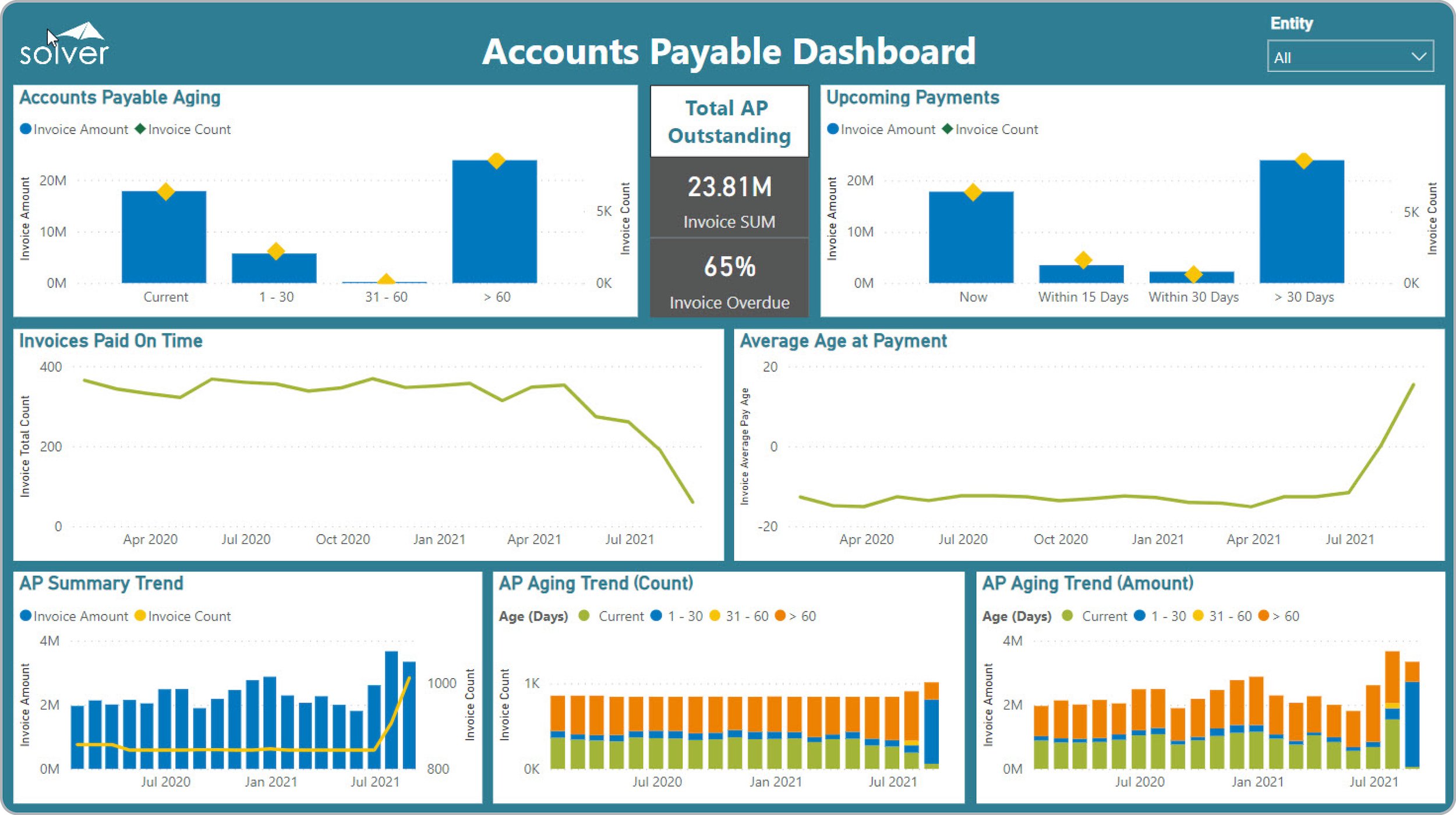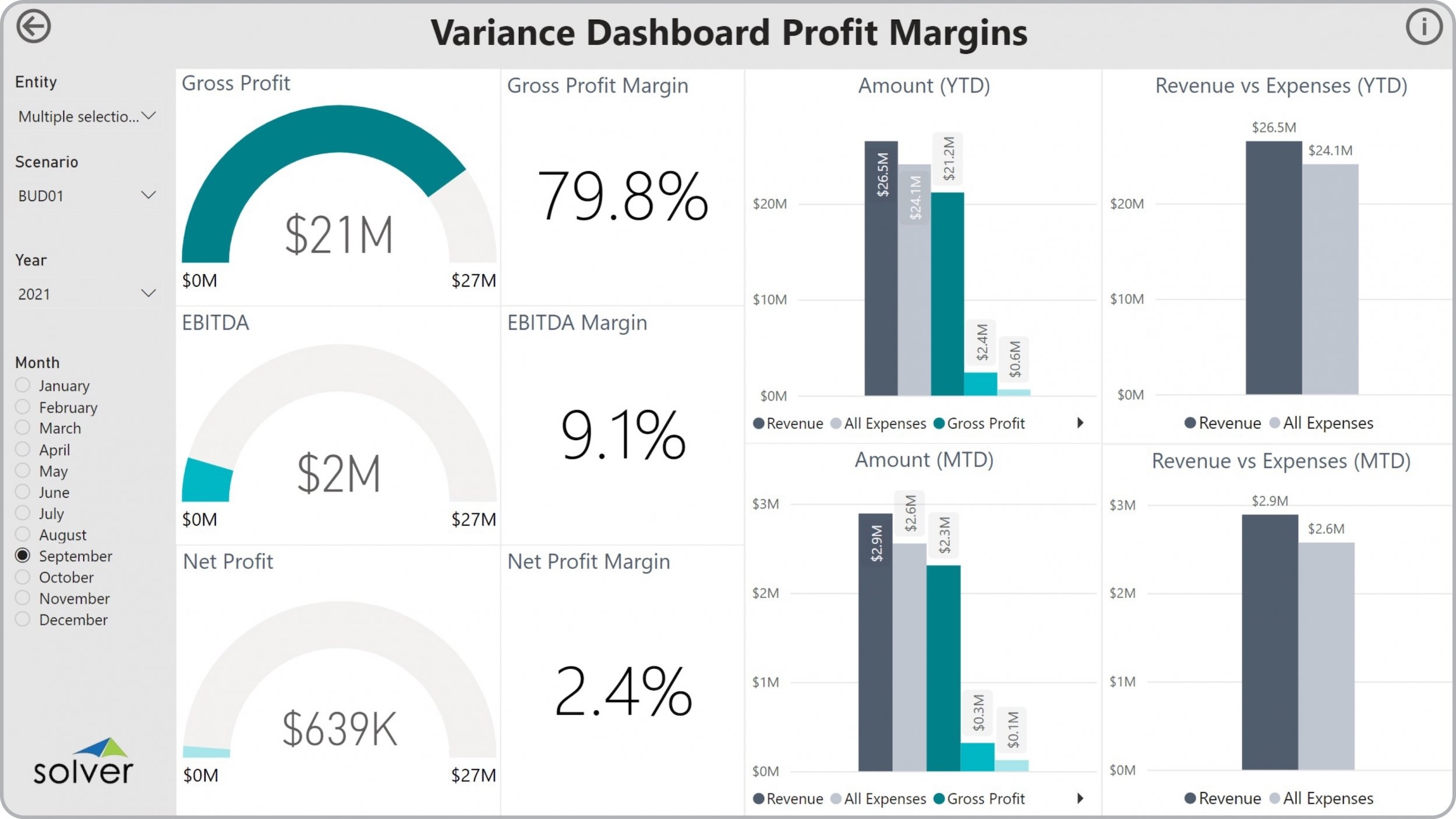This article will look at the best options Intacct customers have for powerful, modern dashboard software to upgrade your analytics for business end users at all levels.
Dashboards, data visualizations, graphical scorecards, charts. Whatever you call them, they’re everywhere. And that’s because they are a top priority for financial executives, according to a
Gartner study on Financial Executive International CFO Technology. It probably makes sense to you. Amidst the fast pace of the business world today, all members of our teams need easy-to-read, quickly accessible data analyses. Dashboards or data visualizations are charts, graphs, and scorecards that demonstrate data trends, successes, and challenges, employing key performance indicators (KPIs), for management of a project, a department, or the entire company.

Accounts Payable Dashboard with summary of aging and preview of upcoming payments, as well as trend analysis.
Dashboards of all kinds are quite prevalent, whether you’re in your vehicle, looking at a credit card spending analysis, or reviewing your Google Analytics web-site activity report. BI data visualizations fit into this category of dashboards because you can get an understanding of data trajectories. However, BI dashboards are different in their interactive nature. You can adjust and configure your analytics to get the data you want. Most BI dashboards are equipped with drill-to- and drill-down functionality, so you can customize your analyses to maximize your information and make more informed decisions. Okay, okay, dashboards are great – you get it. In this article, I’m going to discuss the feature and functionality considerations for dashboard software to upgrade your Sage Intacct experience. Data visualizations can pull financials from
multiple sources. If you need real-time analytics and only for your financial data, you use Sage Intacct’s native visualization capabilities. Live analysis is preferable for professionals who need analyses of up-to-the-minute financial information – or smaller companies that really only need simple accounting system dashboards, without the resources to manage a Corporate Performance Management (CPM) or BI data store, like an online analytical processing (OLAP) cube or a data warehouse. Mid-sized and bigger corporations, however, typically require more than core financial data, and faster and more powerful performance for their dashboards, which you can’t usually achieve with a live Sage Intacct dashboard.
BI and CPM data store integrations enable bigger organizations to generate dashboards without making the Sage Intacct database sluggish with a lot of data queries for real-time data visualizations. If you have several Sage Intacct users on your team, who sometimes query data at the same time, a cloud-based data store provides a high performance. With a data warehouse or cube, you will have to replicate your data to the storage space, but depending on a separate platform means you can avoid slowing down Sage Intacct. Additionally, a CPM and BI data store invites you to house other data source information in one place, such as payroll data, CRM data, web site statistics, project data, etc. Some third party software manufacturers also offer hybridity in their tools, so you can decide how you would like to integrate your data. Maybe you can relate: some organizations prefer a live analysis for urgent analytics or deadlines requiring up-to-date information, but would like a cloud-based data store for more routine processes. Some executives require real-time operational information analyses, like inventory or sales graphical scorecards. On the other hand, regular dashboards can – and typically are produced with a cube or a data warehouse. And the good news: hybridity like this doesn’t have to be out of your financial reach. Cost is just one consideration out of many to make in your shopping process. Let’s discuss technology platforms. Some independent software vendors (ISVs) are producing dashboard solutions on a proprietary server, while most are now running as multi-tenant applications in the public cloud. These tools function on an interface that has been designed outside of the ubiquitous and flexible Excel. The aesthetics and power might be impressive, but with these platforms, you can expect a longer learning curve for your business end users because they’ve never seen the formatting before. Furthermore, Excel and Sage Intacct have native charting functionality, but are usually
restricted in their abilities because that is not their main purpose as software. And that’s why cloud-based Excel add-in software are so popular.

Ready-to-use Profitability dashboard template from Solver with pre-built Sage Intacct integration
Excel add-in solutions provide you the advantage of familiarity with the internationally trusted spreadsheet application as you use the upgrades and added functionality that enable you to design and produce dashboards. Excel’s native dashboard function allows you to craft visualizations within a workbook, but ISVs are continually developing more powerful, user friendly dashboard tools, driven by consumer demand. Due to the ease of use, Excel add-in software is likely going to be the simplest to deploy, but the Internet arguably offers a more flexible option.
Web-based software is dominating the dashboard marketplace today because your data is accessible from anywhere you can connect to the Internet – and dashboards have followed this trend. Most third party software vendors now offer their data visualization solutions as cloud subscriptions with automated updates providing just as many choices for dashboards, KPIs, and drill-down abilities.
What is the Effort to Implement a Dashboard Solution for Sage Intacct? Most Sage Intacct customers want their connected apps, including CPM tools and dashboards, to be cloud based. Key questions that quickly come up are: how hard is it to integrate to Sage Intacct and how much cost and effort does it take to get up and running? The answer typically is weeks or months of effort and tens of thousands of dollars in services. However, Sage Intacct software partners, like
Solver, that work very closely with Sage and its partner channel, have developed pre-built integrations as well as out-of-the-box financial reports, planning input templates and Power BI dashboards. For example,
Solver’s QuickStart integration to Sage Intacct can get a company up and running in a single day with 100+ pre-built budget and forecast input templates, Power BI financial dashboards, as well as financial reports. All of these ready-to-use templates can be selected and downloaded at no additional cost from a continuously growing
Template Marketplace. Along the same lines, mobile dashboards are gaining in popularity, with professionals on-the-go with only mobile devices at hand. Analysis and/or decision-making deadlines do not wait until you’re back in the office, so mobile dashboard applications answer that need. Only some vendors, like Microsoft with their Power BI application, are producing mobile dashboards at this point, and due to the size of the screen, they tend to focus on one chart or KPI at a time. And there are a few solutions offering the flexibility of all three modes: Excel, web and mobile dashboards. It is currently rare for an ISV to develop a solution that offers hybridity for flexible and mobile access to data visualizations. Even better – software that is positioned within a comprehensive suite of CPM and BI tools. You can even find dashboard software that is discounted if you bundle it with other product(s). The premier BI and CPM suites are built with security, fully integrated solutions, and sometimes web portal options, but they are just one team of vendor, partner, consultant and support for all of your solutions. Big picture savings of time, energy, and money. Sage Intacct is a robust accounting system, and if you are adept at utilizing it, you might find software additions to be excessive in terms of implementation, training, and management, particularly if the tool is not easy to use. But the top business user friendly data visualization solutions can accelerate and upgrade analysis processes, which can simplify company decision-making. You might be overwhelmed by all you need to consider when shopping around for the best product, and
Solver would be happy to answer questions and generally review Solver's Excel, web and/or mobile-based, easy-to-use Power BI dashboards module stand-alone with a pre-configured Sage Intacct integration to drive collaborative, streamlined decision-making capabilities.


